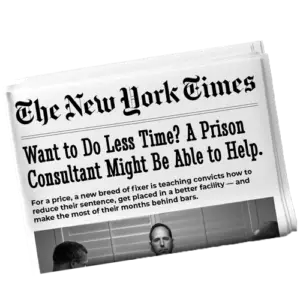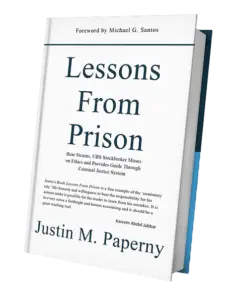Michael Santos Introduces the BOP Directive
White Collar Advice:
“Michael, as you know, the Bureau of Prisons issued another directive on June 17, and people are asking questions like: What does this mean? What does stackable mean? I’m in prison now or I’m going next week. Does that mean if I’m eligible to go to the Halfway House, they’re directly going to send me home?”
Michael Santos:
“Let’s make sure that everybody understands we’re not here just to give a monologue, but to really respond to your questions. We’re here to help each other prepare for the best possible outcome going forward.”
Michael began by putting this policy in context. He explained how sentencing laws have shifted since the 1980s and why the implementation of even good legislation like the First Step Act is always met with resistance.
The History of Resistance Inside the BOP, Including the BOP Memo
“The movement in every phase of the bureaucracy is to resist. That’s been always the movement.”
Michael didn’t mince words about the institutional reluctance that has always defined BOP culture. Whether it was the Sentencing Reform Act, Booker, or the First Step Act, real-world implementation has consistently lagged behind the law.
But now, something has changed.
The June 17 BOP Memo Directive—Full Text and Explanation
At this point, I shared the official language from the new memo issued by the Bureau of Prisons. Here is the full directive, interwoven with commentary from Michael’s analysis:
“WASHINGTON, DC – In order to restore integrity and fiscal responsibility to the federal prison system, the Bureau of Prisons (BOP) today issued a policy memorandum to staff directing the robust and comprehensive implementation of both the First Step Act of 2018 and the Second Chance Act of 2008—two bipartisan cornerstones of modern criminal justice reform.”
Michael Santos:
“That is not traditional BOP language. The memo says: Avoid wasting millions of taxpayer dollars on unnecessary incarceration. That’s a massive shift.”
“This is the dawn of a new era, one in which the Bureau of Prisons will realize the full potential of the First Step Act and Second Chance Act,” said BOP Director William K. Marshall III. “The comprehensive policy outlined today will eliminate barriers to maximize the availability of home confinement to those who qualify for community release under the First Step Act and Second Chance Act. This change in policy will fully operationalize the laws as intended by Congress and ensure a smoother transition for many individuals to return to productive lives after incarceration.”
Michael explained that new leadership is central to this shift. He walked through the significance of a formerly incarcerated Deputy Director now serving in senior leadership and why that matters:
“We’ve never had that in the Bureau of Prisons. Not an advocate from the outside. Someone in leadership.”
The BOP memo promises:
- Avoid wasting millions of taxpayer dollars on unnecessary incarceration
- Reduce strain on prison bedspace and staffing
- Eliminate prolonged and unnecessary burdens on inmates and their families—particularly those with stable home environments and strong community ties
It also mandates four operational principles:
1. “FSA Earned Time Credits and SCA eligibility will be treated as cumulative and stackable, allowing qualified individuals to serve meaningful portions of their sentences in home confinement when appropriate.”
2. “Conditional Placement Dates—based on projected credit accrual and statutory timelines—will drive timely referrals, not bureaucratic inertia.”
3. “Stable housing and community reintegration readiness, not past employment, will guide placement decisions.”
4. “RRC bed capacity limitations will not be a barrier to Home Confinement when an individual is statutorily eligible and appropriate for such placement.”
“This action marks a bold shift from years of inaction toward a policy rooted in public safety, fiscal responsibility, and second chances,” Marshall continued. “By empowering the agency to release more people who are ready to return to society, we not only save taxpayer dollars, we strengthen families, ease overcrowding, and build safer communities.”
What the June 17 BOP Directive Means—And Why Preparation Still Decides Who Goes Home Early
How to Earn an “A” Instead of an “F”
Michael Santos:
“If somebody has a 5-year sentence, that’s 60 months flat out. If I’m going to give you a grade, an F is that you would do 60 months. That means everything went wrong. You had to do the whole sentence. That’s a failure.”
“None of you are going to be failures—as is obvious. You’re thinking about this now. But what’s an A?”
He continued with one of the most helpful framing tools we’ve seen him use: visualizing time served as a grading scale.
“If everything worked out perfectly well… maybe an A is 20 months on 60.”
Then he asked the core question:
“What can I engineer to make me the best possible candidate?”
Why the BOP Memo Still Requires Personal Documentation
Even with the directive’s promise of stackable credits and early home confinement, Michael made it clear:
“I would never leave it in the hands of a bureaucracy. Ever.”
He emphasized that no one—lawyer, case manager, or program coordinator—should be working harder than the person serving the sentence. The preparation must be visible, verifiable, and consistent.
“That’s what I did for 9,500 days in prison. So when Justin says, ‘I won’t ask you to do something I didn’t do,’ I’m saying that is what I did through prison. It’s what I’m still doing today.”
Live Q&A—Michelle Asks About Her Loved One at El Reno
Michelle:
“I have somebody incarcerated doing a 60-month thing. His points and all of that’s low. How soon could I expect him home with him? He has all of his… time credits. He’s been doing classes. He’s been doing programs, work programs and all of that inside.”
Michael Santos:
“Can I ask you some questions? Is there a place I can go look and see that he’s done all of these things?”
Michelle responded honestly: she wasn’t sure. Michael used that moment to highlight the need for transparent, centralized documentation through Prison Professors Talent.
“That’s not the same thing as having it very public and being able to see. What we want to do… is profile who’s working harder than anyone else.”
He pulled up the leaderboard on the platform and explained how it allows him—and soon, administrators—to see who is truly earning the right to be considered for early release.
“We want him to say, ‘Okay, I cannot change the fact that a Federal judge sentenced me to 60 months. But what can I do to change what happens next?’”
Creating a Tribe and Earning Points
Michael encouraged Michelle—and everyone else watching—to not only help their loved one build a profile, but to start forming a tribe:
“Every time they’re working hard and submitting something, they’re getting a point—and your loved one’s getting a point. That leaderboard is what I use when I go speak with administrators.”
He shared his vision of showing wardens a list of people working the hardest—not based on opinion, but measurable public effort.
“Why is this guy in jail? Look at how hard he’s working. I don’t need to know him. But I can see he doesn’t want to be a criminal—because you can’t fake this.”
Michael Responds to Dr. Gina
Dr. Gina’s husband was pre-sentencing. She asked whether the First Step Act applied, since his charges were serious but nonviolent.
Michael:
“The thing about laws is—they change.”
He walked her through how to check the BOP website for disqualifying offenses. But more importantly, he emphasized the distinction between earned time credits and eligibility under the First Step Act as a whole.
“Every person in prison qualifies for the First Step Act—if the crime happened after November 1st, 1987.”
He explained how furlough policies and stacking time credits could still provide opportunities, especially if her husband begins to document real efforts now, even before sentencing.
“I’m going to write a blog that gives you the instructions for how to do this. It’ll be up by tomorrow.”
The System Is Changing—But It’s Still a Fight
Michael made it clear: while the June 17 directive is real progress, it doesn’t eliminate obstacles. Instead, it gives people a policy they can use to argue for themselves.
“This action marks a bold shift from years of inaction… But you’ve got to just think to yourself—everybody’s got to use your God-given mind and say: ‘Who grows up and says, I want to build my career working in the prison system?’”
“Is that person thinking, ‘I really want to help?’ Probably not.”
Why Documentation is the Only Leverage
Throughout the rest of the webinar, we heard from people like:
- Dawn, whose husband is nearing the end of a 78-month sentence but isn’t getting credit
- Dominique, whose husband at FCI Phoenix lost motivation after years of effort
- Christian, on pretrial, wondering if the First Step Act applies to gun charges
- Lisa, frustrated that her fiancé had no programming available
- J.V., typing out webinar transcripts by hand for her son at MDC Brooklyn
- Paige, whose daughter is stuck in limbo waiting for a halfway house bed in Miami
- David, whose son was designated to a medical center but has no access to any programs
In each case, Michael responded with practical advice—not false hope. He encouraged every family member to:
- Help build the loved one’s Talent Profile
- Submit written work (book reports, reflections, letters) to Roman@PrisonProfessors.org
- Understand that no policy is a shortcut without documentation
“Do you work hard enough to demonstrate you’re a great candidate to get out of prison?”
We ended the webinar where we began—with a reminder:
The directive is important. But it’s not a solution. You still have to build the record.
If you want to get started—or help your loved one do this work—schedule a call with us. We’ll walk you through:
- How to build a First Step Act–aligned release record
- How to create a transparent public profile
- How to position for early release based on what the directive now makes possible.
Justin Paperny



